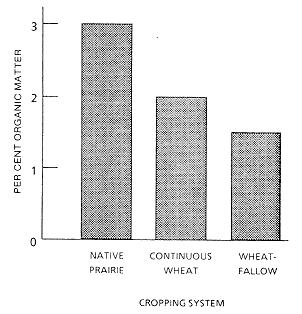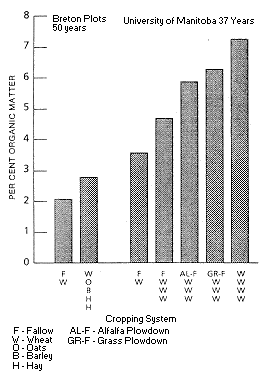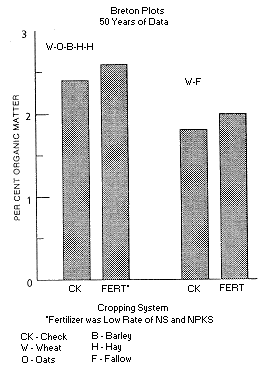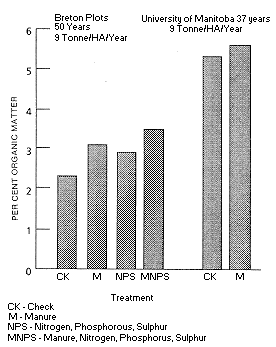| | Introduction | What is organic matter? | Organic matter in virgin and cultivated soils | Effects of organic matter decline | Managing soil organic matter
Introduction
Soil degradation has become a major concern in Canada. Erosion, salinization, acidification and loss of organic matter are the main forms of soil deterioration. This publication deals with the role of organic matter in soil productivity and the effects of various management practices on soil organic matter.
What is Organic Matter?
Soil organic matter consists of a variety of components. These include, in varying proportions and many Intermediate stages:
- raw plant residues and microorganisms
(1 to 10 per cent)
- "active" organic traction (10 to 40 per cent)
- resistant or stable organic matter (40 to 60 per cent) also referred to as humus.
Raw plant residues, on the surface, help reduce surface wind speed and water runoff. Removal, incorporation or burning of residues predisposes the soil to serious erosion.
The "active" and some of the resistant soil organic components, together with microorganisms (especially fungi) are involved in binding small soil particles into larger aggregates. Aggregation is important for good soil structure, aeration, water infiltration and resistance to erosion and crusting.
The resistant or stable fraction of soil organic matter contributes mainly to nutrient holding capacity (cation exchange capacity) and soil color. This fraction of organic matter decomposes very slowly and therefore has less influence on soil fertility than the "active" organic fraction.
Organic matter in soil serves several functions. From a practical agricultural standpoint, it is important for two main reasons. First as a "revolving nutrient bank account"; and second, as an agent to improve soil structure, maintain tilth, and minimize erosion.
As a revolving nutrient bank account, organic matter serves two main functions:
- Since soil organic matter is derived mainly from plant residues, it contains all of the essential plant nutrients. Accumulated organic matter, therefore, is a storehouse of plant nutrients. Upon decomposition, the nutrients are released in a plant-available form.
- The stable organic fraction (humus) adsorbs and holds nutrients in a plant available form.
Organic matter does not add any "new' plant nutrients but releases nutrients in a plant available form through the process of decomposition. In order to maintain this nutrient cycling system, the rate of addition from crop residues and manure must equal the rate of decomposition.
If the rate of addition is less than the rate of decomposition, soil organic matter will decline and, conversely if the rate of addition is greater than the rate of decomposition, soil organic matter will increase. The term steady state has been used to describe a condition where the rate of addition is equal to the rate of decomposition.
Fertilizer can contribute to the maintenance of this revolving nutrient bank account by increasing crop yields and consequently the amount of residues returned to the soil.
Organic Matter in Virgin and Cultivated Soils
Soils in Alberta are divided into soil groups (zones) based on the amount of organic matter they contain. They occur in geographic zones from the southeast to the northwest and are identified as the Brown, Dark Brown, and Black Chernozemic (prairie) soils.
The Brown soils have the least amount of organic matter because of the relatively small inputs of plant residues contributed by the short grass prairie vegetation under which these soils developed. Black soils developed under cooler and wetter conditions which allowed for more grass growth and thus a greater accumulation of organic matter.
Further north and west, trees became the dominant vegetation. Soils influenced by forest vegetation for a moderate length of time constitute the Dark Gray or transitional soils. Where the forest cover was established for a longer period, Luvisolic (forest) soils developed. Organic (peat) soils. occur in low lying areas throughout the Black, Dark Gray and Gray soil zones. These soils are saturated with water for much or all of the year thereby reducing the rate of organic matter decomposition.
The amount of soil organic matter characteristic of virgin and cultivated soils in the various zones is shown in Table 1. Cultivation generally has resulted in a 30 to 50 per cent loss of organic matter.
Table 1. Organic matter in native and cultivated soils (per cent)
| Soil zone | Virgin | Cultivated |
| Brown | 3-4 | 2-3 |
| Dark Brown | 4-5 | 3-4 |
| Black | 6-10 | 4-6 |
| Dark Gray | 4-5 | 2-3 |
| Gray | 1-2 | 1-2 |
Before our soils were cultivated, they had achieved a "steady state". In most of our prairie soils, the increased rate of decomposition associated with cultivation, combined with the low rates of crop residue addition associated with crop-fallow rotations has caused a fairly rapid decline in soil organic matter. The rate of decline decreases with time as the amount of total soil organic matter decreases and particularly as the "active" organic fraction is depleted.
Cultivation of soils that are naturally high in organic matter will usually result in a decrease of organic matter. In the case of Luvisolic soils, their poor physical properties and low fertility have encouraged the use of forages, fertilizers, manure and judicious tillage. Such management practices have resulted in an increase in soil organic matter on Luvisolic soils, whereas excessive tillage, fallowing and minimal fertilization have lead to further depletion of the soil organic matter.
Effects of Organic Matter Decline
As stated in the introduction, soil degradation is becoming a major concern in Canada. Loss of organic matter is often identified as one of the main factors contributing to declining soil productivity, but it is misleading to equate a loss in soil organic matter with a loss in soil productivity.
Soil organic matter contributes to soil productivity in several ways, but there is no direct quantitative relationship between soil productivity and total soil organic matter. In fact, it has been the decline in organic matter that has contributed to the productivity of the crop-fallow system.
This decline in organic matter has resulted in the release of large amounts of plant nutrients, particularly nitrogen. For example, a decrease in soil organic matter of 2 per cent releases about 2,400 lb/ac of nitrogen. If this decline occurred over a 60 year period, an average of 40 lb/ac/yr of plant-available nitrogen has come from the soil organic matter. We therefore view prairie soils which had relatively high levels of organic matter as being nitrogen fertile, but this fertility could only be attained under a management system that allowed for organic matter to decline. Frequent fallowing has been a major factor contributing to this decline.
Insofar as organic matter contributes to improved soil physical properties (e.g., tilth, aggregation, moisture holding capacity and resistance to erosion) increasing soil organic matter will generally result in increased soil productivity. But on many soils, suitable soil physical properties occur at relatively low levels of organic matter (2-4 per cent).
A level of organic matter higher than required to produce suitable physical properties is beneficial in that the soil has a greater buffering and nutrient holding capacity, but it does not contribute directly to soil productivity. If soils are managed so organic matter is not declining (steady-state), soils higher in organic matter (e.g., 8 per cent) are not inherently more productive or fertile than those that have less organic matter (e.g., 5 per cent).
To equate the ability to supply nutrients with total soil organic matter is not valid. The "active" fraction of organic matter is a more reliable indicator of soil fertility than is total soil organic matter. In cultivated soil, the "active" fraction is influence mainly by previous management.
Soil organic matter cannot be increased quickly even when management practices that conserve soil organic matter are adopted. The increased addition of organic matter associated with continuous cropping, and the production of higher crop yields, are accompanied by an increase in the rate of decomposition. Moreover, only a small fraction of crop residues added to soil remains as soil organic matter.
After an extended period of time, the return of all crop residues and the use of forages in rotations with cereals and oilseeds may significantly increase soil organic matter, particularly, the "active" fraction.
Managing Soil Organic Matter
There have been vast changes in the nature of agricultural production. In the past, farms were small, and much of what was produced was consumed on the farm. This system allowed for the limited removal of soil nutrients since there was an opportunity to return most of the nutrients back to the land.
The advent of the internal combustion engine, migration from rural to urban communities, increasing farm size and specialization in production have resulted in a system of production where there is greater removal of plant nutrients from the soil and less opportunity for nutrient cycling.
Maintenance of organic matter for the sake of maintenance alone is not a practical approach to farming. It is more realistic to use a management system that will give sustained profitable production.
The greatest source of soil organic matter is the residue contributed by current crops. Consequently, crop yield and type, method of handling residues and frequency of fallow are all important factors. Ultimately, soil organic matter must be maintained at a level necessary to maintain soil tilth. The effects of specific management practices are discussed below.
Summerfallow
Summerfallowing accelerates the loss of organic matter. Aeration of the soil associated with tillage, and the increase in soil temperature and moisture results in increased organic matter decomposition. Since little In the way of residues are added to the soil, a net loss of organic matter occurs. Research has shown that as the frequency of fallow increases, the amount of soil organic matter decreases (Figure 1).

Figure 1. effect of frequency of fallow on per cent organic matter.
Summerfallowing for moisture conservation may be a necessary practice in the Brown and Dark Brown soil zones. However, it must be questioned in the Black and the Gray soil zones. Periodic fallowing may be acceptable in the higher rainfall regions for control of persistent perennial weeds and volunteer grains in pedigreed seed production.
In the crop-fallow system common to the prairie region, the nitrogen removed has far exceeded that gained from crop residues, manure, legumes and fertilizer. The large reserves of nitrogen present in the organic matter of our prairie soils have been the major source of nitrogen in this cropping system. Continued reliance on soil organic matter reserves to supply the nitrogen requirements of crops will ultimately lead to a decline in soil productivity, and increased soil erosion.
When a change from a cropping system involving fallow to continuous cereal grain production, the nitrogen requirement increases. The nitrogen requirement is greatest in the first few years of continuous cropping as the nutrient cycling process adjusts to the new cropping system.
Crop rotations
The value of forage crops in rotations with cereals and oilseeds has long been recognized, especially in the Luvisolic soils. Several long-term crop rotation studies conducted in Western Canada have shown that crop rotations involving perennial forages tend to stabilize soil organic matter at a higher level than crop rotations involving summerfallow.
Figure 2 summarizes data obtained by the University of Alberta from the Breton Plots and the University of Manitoba. The Breton Plots compared a two-year fallow-wheat rotation with a five-year rotation involving wheat, oats and barley followed by two years of hay production.
In research done by the University of Manitoba, the effects of various cultural practices on the level of organic matter are compared. It is interesting to note that the highest level of soil organic matter was maintained under continuous cropping.
The beneficial effects of perennial forages are the result of:
- a more extensive root system and crop aftermath contributing more organic matter to the soil,
- the fibrous nature of the root system of perennial grasses. These are particularly effective as a binding agent in soil aggregation,
- Nitrogen fertility enhancement by the growth of legumes,
- increased permeability of dense subsoils because of the deep penetrating tap roots of perennial legumes, especially alfalfa.
- a reduced rate of organic matter decomposition in the absence of tillage.

Figure 2. Effect of rotation on soil organic matter
In the brown and dark brown soil zones, perennial forages grown for forage production or as a plowdown crop may jeopardize subsequent cereal crops because they deplete soil moisture reserves.
Fertilization
Fertilizers will generally increase soil organic matter because the increased crop growth returns larger amounts of residues to the soil.
Data obtained from the Breton Plots is summarized in Figure 3. The increase in organic matter is less than what might be expected with current farming practices since all the straw had been removed from the plots. To determine the fertilizer effect, two fertilizer treatments were averaged, one involving a low rate of nitrogen and sulphur and another involving a low rate of nitrogen, phosphorus, potassium and sulphur.
One would expect that with higher rates of fertilization, higher yielding varieties, and the return of all crop residues, the effect of fertilizers on organic matter would be greater than that shown in Figure 3.

Figure 3. Effect of fertilizer on soil organic matter.
Plowdown
Legume plowdown has received considerable attention in recent years as an alternative to the use of nitrogen fertilizers. However, when considering this option in a cropping program, the amount of nitrogen added by the legume, as well as the loss of one year of production, the cost of seed and the expected yield increase must be kept in mind.
Strictly as a source of nitrogen, the value of a legume plowdown is questionable. The amount of nitrogen fixed by a legume is dependent upon the type of legume, the amount of vegetative growth, the nature of the soil and environmental conditions. As a source of organic matter, legume plowdown is valuable, however, perennial forage is more effective than legume plowdown for increasing soil organic matter.
Nitrate nitrogen which accumulates following legume plowdown is subject to loss, particularly in wet, poorly drained soils. To minimize this, legumes should be plowed down in the fall rather than mid-summer to reduce nitrate accumulation and subsequent loss.

Figure 4. Effect of manure on soild organic matter.
Conclusion
The cultivation of prairie soils has generally resulted in a decline in organic matter of 30 to 50 per cent. A product of this decline has been the release of large amounts of plant nutrients, particularly nitrogen. Crop rotations with a high frequency of summerfallow have relied on the nitrogen released from soil organic matter to supply crop requirements.
More frequent or continuous cropping, less frequent tillage, the production of high yields and the return of crop residues will help to maintain soil organic matter at a satisfactory level. Perennial forages are effective for maintaining or increasing soil organic matter.
Prepared by:
J. Lickacz and D. Penny
Plant Industry Division
Source: Agdex 536-1. |
|